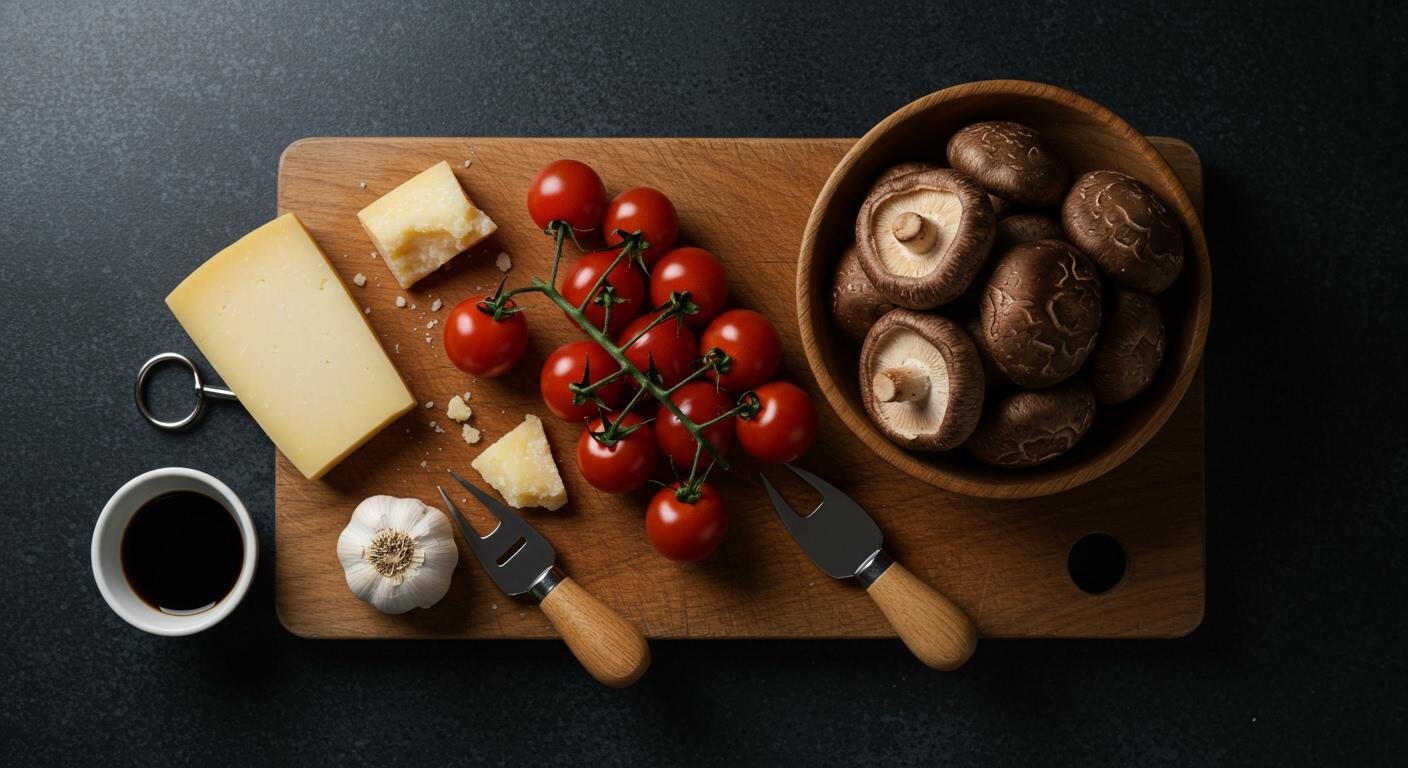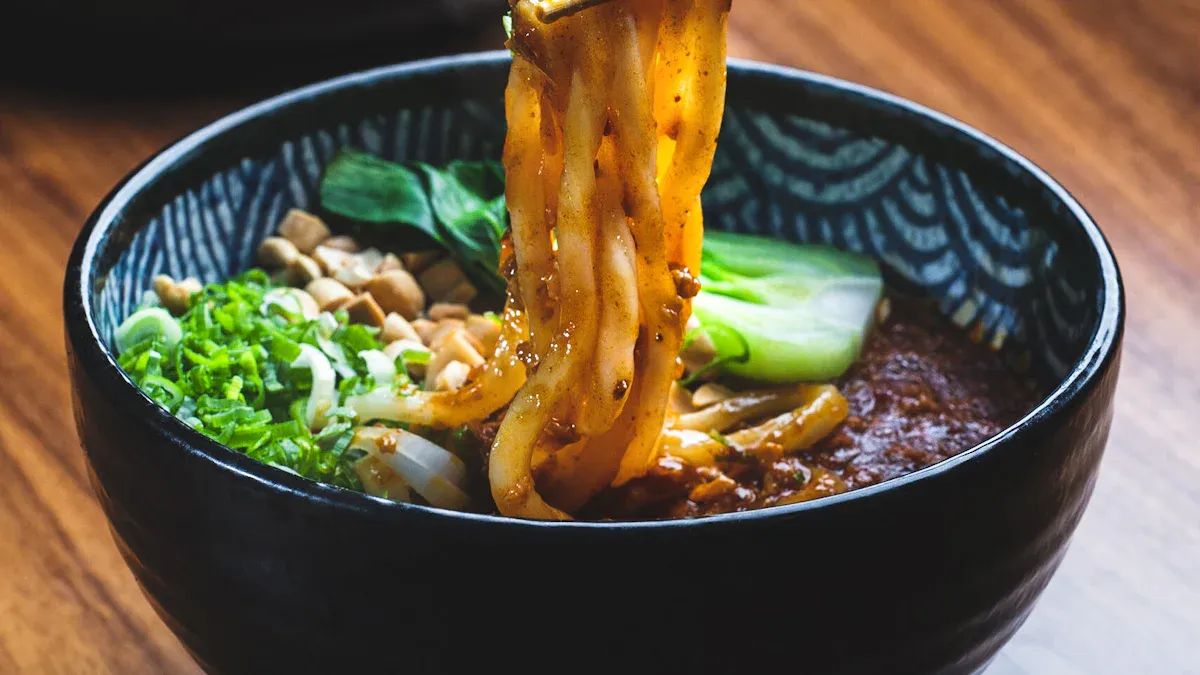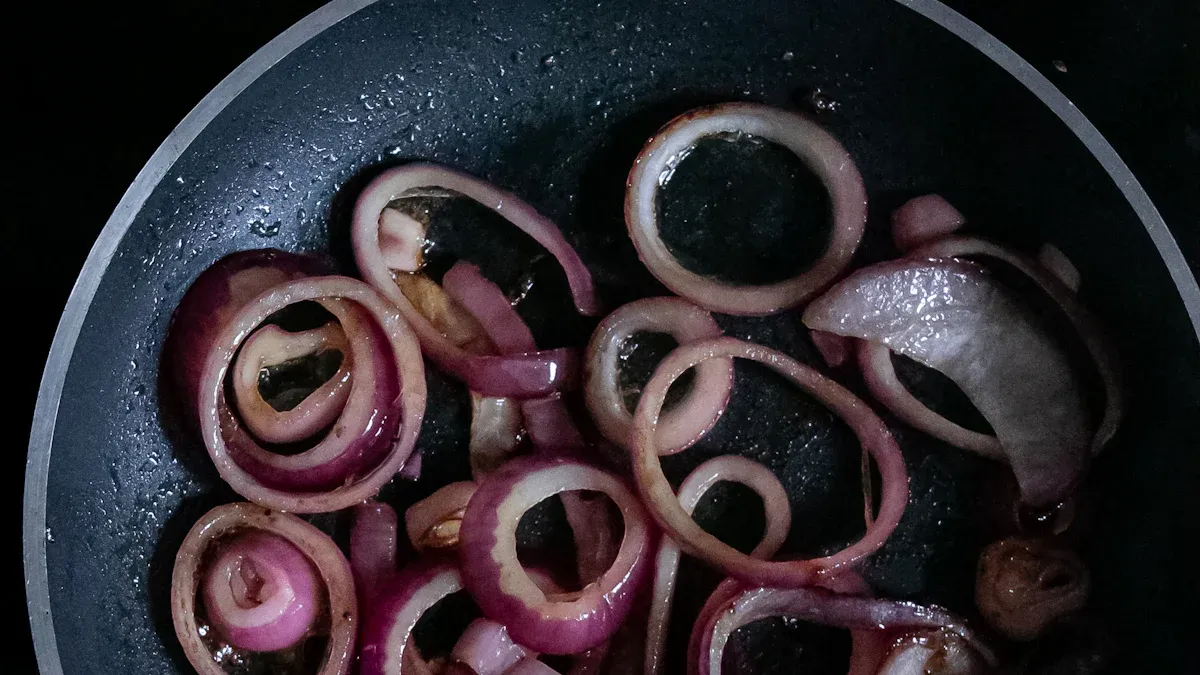Your 2025 Guide to Build Flavor with Umami
Table of Contents

Do you want to make flavorful food with less salt? What if you could build flavor without reaching for the salt shaker? The secret is umami, the fifth taste. It is the key to creating deep, savory flavor in your food.
You’re not alone in this goal! A survey found that 52% of US adults want low-sodium options when dining out. Mastering umami flavor helps you achieve this at home with your favorite food.
While health organizations recommend limiting sodium, average intake for many is much higher:
| Category | Recommended Daily Sodium Intake | Average Global Daily Sodium Intake |
|---|---|---|
| Health Organizations | < 2.3 g/day (~1 tsp salt) | N/A |
| Most Populations | N/A | 3 to 6 g/day |
| United States (men) | N/A | 4.1 to 4.4 g/day |
| United States (women) | N/A | 3.0 to 3.5 g/day |
This guide provides a simple roadmap to mastering this powerful taste.
HOW TO SEASON FOOD: THE UMAMI METHOD
Learning how to season food with umami starts with understanding this unique taste. It is a powerful tool for building deep flavor in your meals. This method helps you create delicious food with less need for salt.
DECODING THE FIFTH TASTE
You probably know the four basic tastes: sweet, sour, salty, and bitter. Umami is the fifth basic taste. A Japanese scientist, Dr. Kikunae Ikeda, first identified it in 1908. He noticed a distinct taste in his seaweed broth that was not one of the other four. It took many years, but scientists officially recognized umami in 1985.
So, what does umami taste like? People often describe it as a pleasant “brothy” or “meaty” flavor. It creates a long-lasting, mouthwatering feeling that coats your tongue. This savory sensation makes food feel more satisfying.
UMAMI VS. SALTINESS
Your tongue has different tools for different jobs. It uses specific taste receptors to tell umami and saltiness apart. Saltiness activates ion channels, while umami activates special G protein-coupled receptors. Though they are separate, umami can enhance the perception of saltiness. This means adding umami flavor can make your food taste salty enough, even with less actual salt. This is a key secret for how to season food for better health.
THE ROLE OF GLUTAMATE
Glutamate is the star of the umami show. It is an amino acid found naturally in many foods. When glutamate hits your tongue, it binds to specific receptors like T1R1/T1R3 to create the umami taste.
Other compounds can also boost this effect.
- Inosinate: Found in meats and fish.
- Guanylate: Found in dried mushrooms.
When you combine these with glutamate, you create a synergistic effect. This makes the overall flavor much more intense than any single ingredient could achieve. Understanding this synergy is central to learning how to season food effectively.
UMAMI-RICH INGREDIENTS FOR SAVORY DEPTH

You can easily build flavor in your everyday cooking. The key is to stock your pantry with ingredients naturally high in umami. These items work like secret weapons, adding satisfying depth and complexity to your food. Let’s explore some of the most powerful and accessible umami sources.
MUSHROOMS AND TOMATO PASTE
Mushrooms are a fantastic source of umami, especially when dried. The drying process concentrates their flavor compounds. While fresh mushrooms contain glutamate, dried mushrooms also have a high concentration of guanylate, which works with glutamate to create an intense savory taste.
Dried shiitake mushrooms are particularly potent. You can see how they compare to a common fresh umami source:
| Food Item | Free Glutamate Content (mg/100g) |
|---|---|
| Dried shiitake mushrooms | 1,060 |
| Tomatoes | 246 |
Pro Tip: To use dried mushrooms, you can rehydrate them in warm water for 20-30 minutes. Use the mushrooms in your dish and save the flavorful soaking liquid to use as a broth for soups or sauces.
Tomato paste is another pantry staple that delivers a concentrated glutamate punch. To truly unlock its potential and boost umami, you should brown the paste. This simple step caramelizes its natural sugars and deepens its savory flavor.
Here is how you can do it:
- Sauté your aromatics like onion and garlic.
- Add a tablespoon or two of tomato paste to the pan.
- Cook the paste, stirring constantly, for 5-7 minutes until it darkens to a brick-red color.
- Deglaze the pan with a liquid like wine or broth, scraping up any browned bits.
This technique is especially useful for adding a “meaty” depth to vegetarian food.
FERMENTED FOODS: SOY SAUCE AND MISO
Fermentation is a natural process that transforms food and creates incredible flavor. Soy sauce and miso paste are two prime examples. Both are made from fermented soybeans, a process that breaks down proteins and releases a large amount of free glutamate.
A splash of soy sauce can instantly add umami and depth to marinades, stir-fries, and dipping sauces. Miso paste offers a more complex, earthy flavor. You can find different types of miso, each with a unique profile.
| Miso Type | Flavor Profile |
|---|---|
| White Miso (Shiro) | Mild, delicate, and slightly sweet. Perfect for dressings, glazes, and light soups. |
| Red Miso (Aka) | Strong, salty, and robust. Best for hearty stews, braises, and marinades for red meat. |
You can stir a spoonful of miso into soup broth or whisk it into a vinaigrette for a powerful umami flavor boost.
AGED CHEESES: PARMESAN AND GOAT CHEESE
Have you ever wondered why aged cheeses like Parmesan taste so complex and satisfying? The secret is an aging process called proteolysis.
- During the long aging period, enzymes naturally break down the proteins in the cheese.
- This breakdown releases various amino acids, most notably glutamate.
- The longer a cheese ages, the more glutamate accumulates, resulting in a richer umami taste.
Parmigiano Reggiano, aged for 12 months or more, is packed with glutamate. A simple grating over pasta, soup, or roasted vegetables adds a final layer of savory flavor. Softer, younger cheeses like goat cheese also offer a tangy umami kick that brightens up salads and appetizers.
CURED ITEMS: ANCHOVIES, OLIVES, AND CAPERS
Curing is a preservation method that also concentrates flavor. Anchovies, olives, and capers are small but mighty sources of umami.
- Caesar salad dressing
- Pasta sauces like puttanesca
- Pan sauces for steak
Similarly, a handful of chopped olives or a spoonful of capers can add a briny, savory pop to your food, enhancing its overall complexity.
SEAWEED: KOMBU AND NORI
Seaweed is where the story of umami began. In 1908, Japanese scientist Dr. Kikunae Ikeda identified glutamate as the source of the unique taste in his kombu broth.
Kombu is a type of dried kelp and is a cornerstone of Japanese cuisine. It is one of the main ingredients in dashi, a foundational soup stock that enhances the flavor of any food it is cooked with. You can make a simple kombu dashi by gently simmering a piece of kombu in water.
Nori, the roasted seaweed sheets used for sushi, is another great source of umami. You can use it in many creative ways beyond sushi:
- Cut it into thin strips to garnish rice bowls, soups, and salads.
- Crumble it over popcorn for a savory snack.
- Wrap it around pieces of tofu or cucumber for a quick appetizer.
TECHNIQUES TO BUILD FLAVOR WITHOUT SALT

Great cooking goes beyond ingredients. Your cooking techniques are powerful tools to build flavor. Using heat, marinades, and aromatics can transform simple food into something special. These methods are some of the best healthy ways to flavor your meals.
SEARING AND ROASTING
High heat is your friend in the kitchen. Searing and roasting create deep flavor through a chemical process called the Maillard reaction. This reaction happens when the sugars and proteins in food interact at high temperatures, generally above 350°F (177°C). It creates hundreds of new flavor compounds that were not there before, adding a savory, toasty taste to your food. This is a key technique to build flavor. For roasting vegetables, a high temperature is best.
| Vegetable | Roasting Temperature | Roasting Time |
|---|---|---|
| Broccoli & Carrots | 400°F (204°C) | 15-25 minutes |
MARINATING WITH WINE AND HERBS
Marinating is an easy way to add flavor before you even start cooking. A good marinade can tenderize your food and infuse it with taste. Using liquids like wine adds acidity and complexity. Mixing in fresh or dried herbs gives your food another layer of delicious seasoning. This simple step makes your cooking more dynamic.
USING AROMATICS LIKE GARLIC AND ONION
Many great dishes start with aromatics. Garlic and onions are the foundation of flavor in countless recipes. When you gently cook these ingredients, they release sweet and savory notes that enrich your entire dish. You should add aromatics at the beginning of your cooking process to create a flavorful base.
DIY SALT-FREE SEASONING BLENDS
You can take control of your seasoning by making your own blends. This is a great strategy for cooking without salt. A custom salt-free seasoning lets you tailor the flavor to your liking. Combine your favorite dried herbs and spices for a versatile mix. This is a perfect seasoning without salt for any food.
Simple Salt-Free Seasoning Idea: Mix equal parts garlic powder, onion powder, dried parsley, and smoked paprika. This salt-free seasoning adds a smoky, savory kick to vegetables and proteins. You can create many kinds of salt-free seasoning with different herbs and spices.
BEYOND UMAMI: HOW TO PROPERLY SEASON FOOD
Mastering umami is a great start, but to season food properly, you need to understand balance. Great cooking is like conducting an orchestra where every taste—sweet, sour, salty, bitter, and umami—plays a part. Learning how to properly season food means learning how to make these tastes work together. These essential rules of seasoning will help you balance flavors and make your food delicious.
ADDING BRIGHTNESS WITH CITRUS AND VINEGAR
Acidity is your secret weapon for making flavors pop. When you add something acidic like lemon juice or vinegar to a dish, it interacts with your taste receptors and sends a “tangy” signal to your brain. This brightness cuts through richness and enhances other tastes. A squeeze of acid can even make food seem saltier, which is a key part of how to season food with less salt.
Chef’s Tip: 🧑🍳 A splash of vinegar can transform a heavy dish. It works wonders in foods like:
- Chili and stews
- Rich sauces
- Hearty casseroles
This simple addition helps you balance the final flavor of your food.
FINISHING WITH FRESH HERBS
Fresh herbs add a final burst of flavor and aroma that can elevate any meal. The key is knowing when to add them. Delicate herbs have soft leaves and a bright, fresh taste. You should use fresh herbs at the end of cooking to protect their flavor.
According to biomedical research:
When you chew food, aromas from herbs travel to your nose, which is why seasoning with herbs and spices is so effective. For the best result, add these herbs just before serving:
- Parsley
- Dill
- Cilantro
ADDING HEAT WITH CHILES
Adding a little heat with spices like chiles does more than just make food spicy. The main compound in chiles, capsaicin, triggers heat and pain receptors in your mouth. This sensation can actually amplify the other flavors in your food. A touch of heat creates complexity and makes your seasoning more interesting. It’s one of the essential rules of seasoning to balance flavors without overwhelming the dish.
MISO PASTE FOR A SAVORY BOOST
Miso paste is a versatile ingredient that can add flavor in surprising ways. Beyond soup, this savory paste provides a deep umami kick to many dishes. You can use it to create a powerful seasoning for your food. For example, whisk white miso into a lemon vinaigrette for a complex salad dressing. You can also create a simple glaze for salmon or vegetables. This is an easy way to season food properly and add a unique, delicious taste. These essential rules of seasoning help you think creatively about your ingredients.
You now see umami is a powerful, natural way to build flavor in your food. You can create deeply satisfying food with less salt. You just need to layer umami flavor with acidity and aromatics. Your journey to mastering flavor is about discovery, not rules. Start by experimenting with one new idea in your next meal.
Easy Umami Pairings to Try:
- Mushrooms and Cream: The cream enhances the deep umami of mushrooms.
- Parmesan and Eggs: A runny egg yolk with Parmesan creates a rich flavor.
FAQ
Is MSG the same as umami?
MSG, or monosodium glutamate, provides a pure umami taste. Umami is the taste itself, while MSG is one specific ingredient that creates it. You find the same glutamate that is in MSG naturally in foods like tomatoes and cheese.
Can you have too much umami?
Yes, balance is important in cooking. Too much umami can make a dish taste heavy or one-dimensional. You should use umami to enhance other flavors, not overpower them. A well-balanced dish is always the goal.
What are the easiest umami ingredients for beginners?
You can start with simple pantry items to build flavor. These are great choices for your first experiments:
- Tomato paste 🍅
- Soy sauce
- Parmesan cheese
These ingredients add a quick and noticeable savory boost to many dishes.
Does umami exist in sweet foods?
Umami is mostly a savory taste. However, you can find it in some sweet-tasting foods. For example, very ripe tomatoes have both sweet and umami flavors. This combination creates a complex and satisfying taste experience for you.

Poseidon
Master of Nutritional Epidemiology, University of Copenhagen, Herbal Functional Nutrition Researcher
Focus: The scientific application of natural active ingredients such as Tongo Ali, Horny Goat Weed, and Maca to sexual health and metabolic regulation.
Core Focus:
Men: Use a combination of Tongo Ali (an energizing factor) + Maca (an energy reserve) to improve low energy and fluctuating libido.
Women: Use a combination of Horny Goat Weed (a gentle regulator) + Maca (a nutritional synergist) to alleviate low libido and hormonal imbalances.
Stressed/Middle-Aged Adults: This triple-ingredient synergy supports metabolism, physical strength, and intimacy.
Product Concept:
Based on traditional applications and modern research (e.g., Tongo Ali promotes testosterone-enhancing enzyme activity, and icariin provides gentle regulation), we preserve core active ingredients and eschew conceptual packaging—using natural ingredients to address specific needs.
Simply put: I'm a nutritionist who understands "herbal actives." I use scientifically proven ingredients like Tongo Ali, Epimedium, and Maca to help you make "sexual health" and "nutritional support" a daily routine.
